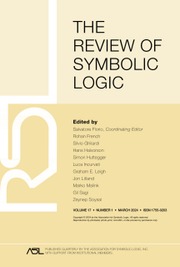No CrossRef data available.
Article contents
THE GENERIC MULTIVERSE IS NOT GOING AWAY
Published online by Cambridge University Press: 27 December 2024
Abstract
The generic multiverse was introduced in [74] and [81] to explicate the portion of mathematics which is immune to our independence techniques. It consists, roughly speaking, of all universes of sets obtainable from a given universe by forcing extension. Usuba recently showed that the generic multiverse contains a unique definable universe, assuming strong large cardinal hypotheses. On the basis of this theorem, a non-pluralist about set theory could dismiss the generic multiverse as irrelevant to what set theory is really about, namely that unique definable universe. Whatever one’s attitude towards the generic multiverse, we argue that certain impure proofs ensure its ongoing relevance to the foundations of set theory. The proofs use forcing-fragile theories and absoluteness to prove  ${\mathrm {ZFC}}$ theorems about simple “concrete” objects.
${\mathrm {ZFC}}$ theorems about simple “concrete” objects.
Information
- Type
- Research Article
- Information
- Copyright
- © The Author(s), 2024. Published by Cambridge University Press on behalf of The Association for Symbolic Logic


